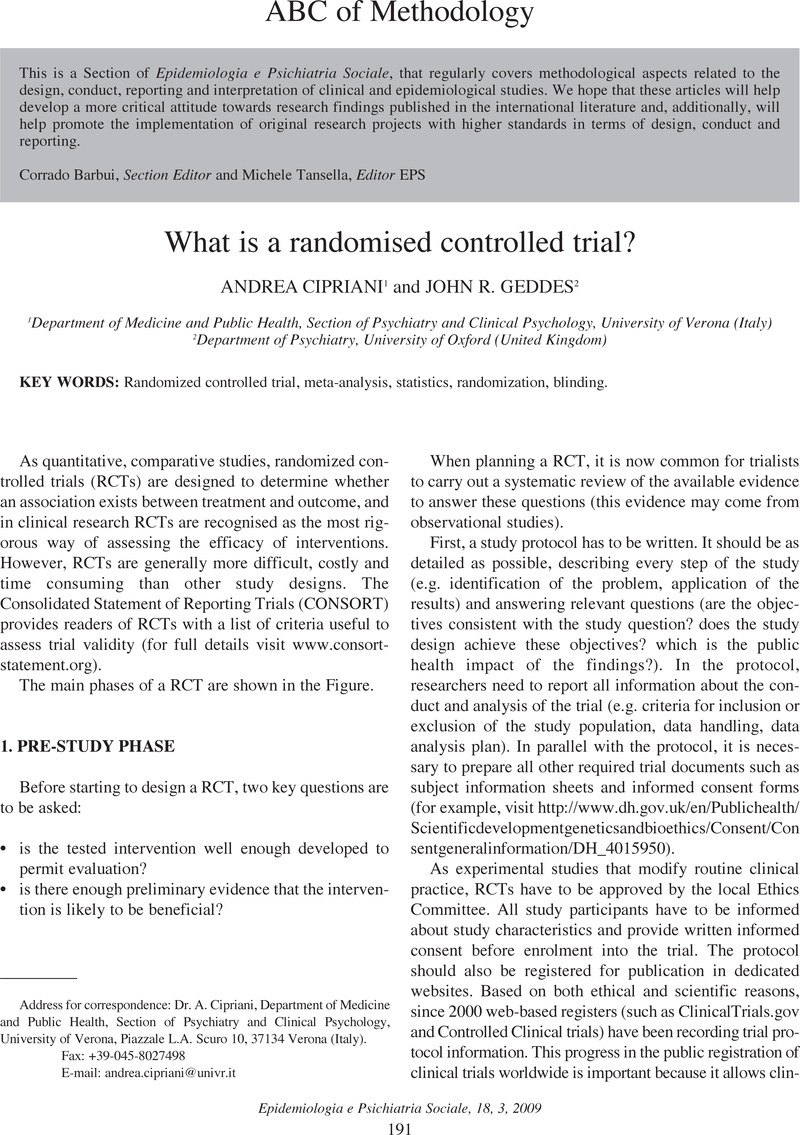Crossref Citations
This article has been cited by the following publications. This list is generated based on data provided by Crossref.
Purgato, Marianna
Barbui, Corrado
and
Cipriani, Andrea
2010.
Assessing risk of bias in randomized controlled trials.
Epidemiology and Psychiatric Sciences,
Vol. 19,
Issue. 4,
p.
296.
Cipriani, Andrea
and
Geddes, John R.
2010.
What is a run-in phase?.
Epidemiologia e Psichiatria Sociale,
Vol. 19,
Issue. 1,
p.
21.
Cipriani, Andrea
and
Barbui, Corrado
2010.
What is a clinical trial protocol?.
Epidemiologia e Psichiatria Sociale,
Vol. 19,
Issue. 2,
p.
116.
Cipriani, A.
Furukawa, T. A.
and
Barbui, C.
2011.
What is a Cochrane review?.
Epidemiology and Psychiatric Sciences,
Vol. 20,
Issue. 3,
p.
231.
Barbui, C.
and
Cipriani, A.
2011.
What are evidence-based treatment recommendations?.
Epidemiology and Psychiatric Sciences,
Vol. 20,
Issue. 1,
p.
29.
Cipriani, Andrea
Koesters, Markus
Furukawa, Toshi A
Nosè, Michela
Purgato, Marianna
Omori, Ichiro M
Trespidi, Carlotta
and
Barbui, Corrado
2012.
Duloxetine versus other anti-depressive agents for depression.
Cochrane Database of Systematic Reviews,
Vol. 2012,
Issue. 10,
Bighelli, I.
and
Barbui, C.
2012.
What is the European Medicines Agency?.
Epidemiology and Psychiatric Sciences,
Vol. 21,
Issue. 3,
p.
245.
Cipriani, Andrea
Reid, Keith
Young, Allan H
Macritchie, Karine
and
Geddes, John
2013.
Valproic acid, valproate and divalproex in the maintenance treatment of bipolar disorder.
Cochrane Database of Systematic Reviews,
Cipriani, A.
and
Barbui, C.
2013.
What is a factorial trial?.
Epidemiology and Psychiatric Sciences,
Vol. 22,
Issue. 3,
p.
213.
Barbui, Corrado
Girlanda, Francesca
Ay, Esra
Cipriani, Andrea
Becker, Thomas
Koesters, Markus
and
Barbui, Corrado
2014.
Cochrane Database of Systematic Reviews.
Purgato, M.
and
Cortese, S.
2014.
Does psychostimulant treatment in children with ADHD increase later risk of substance use disorder?.
Epidemiology and Psychiatric Sciences,
Vol. 23,
Issue. 2,
p.
133.
Licht, Rasmus Wentzer
2015.
Clinical Trial Design Challenges in Mood Disorders.
p.
137.
Bighelli, Irene
Ostuzzi, Giovanni
Girlanda, Francesca
Cipriani, Andrea
Becker, Thomas
Koesters, Markus
and
Barbui, Corrado
2016.
Implementation of treatment guidelines for specialist mental health care.
Cochrane Database of Systematic Reviews,
Vol. 2016,
Issue. 12,
Molnar, Lorena
and
Chopin, Julien
2025.
What Works to Reduce Sex Workers’ Risk of Crime Victimization? A Scoping Review.
Journal of Evidence-Based Social Work,
p.
1.



